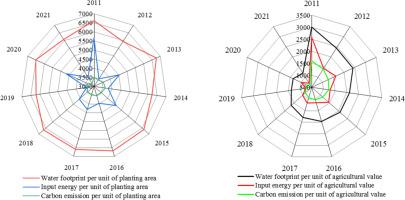作物生产水-能-碳联系的时空演变与耦合分析——以四川省为例
IF 9.5
Q1 ENERGY & FUELS
引用次数: 0
摘要
水、能源和碳是影响作物生产效率的关键因素。全面认识它们之间错综复杂的关系,对实现区域农业的可持续协调发展至关重要。量化这些相互关系对于解决资源短缺和气候变化问题具有重要意义。然而,目前对水-能源-碳关系农业生产的研究主要集中在国家和战略区域层面,对特定区域的研究有限。本文采用足迹理论对四川省2011 - 2021年用水量、能源利用和碳排放进行了评价,通过标准差椭圆分析和空间自相关分析分析了它们的时空演变趋势和空间集聚特征,并通过耦合协调度模型评价了它们之间的协调发展水平。结果表明:农业生产年耗水量为6.25 × 1010m3,能量投入和输出分别为4.07 × 1010MJ和6.71 × 1011MJ,碳排放和汇量分别为3.35 × 1010kg和1.31 × 1011kg。水足迹、能源投入和碳排放的空间密度呈下降趋势,表明它们的集聚效应持续减弱。整体自相关分析不显著。水足迹、能源投入和碳排放的HH集群主要分布在川东北地区。水-能-碳关系的耦合度表现良好,耦合配位度在0.3 ~ 0.5之间。因此,有必要采取水肥一体化管理、有机肥部分替代化肥、推广免耕和少耕等措施,减少水、能源消耗和碳排放。该研究为农业协调管理和可持续发展提供了有价值的见解。本文章由计算机程序翻译,如有差异,请以英文原文为准。

Temporal-spatial evolution and coupling analysis of water-energy-carbon nexus for crop production: A case study of Sichuan Province, China
Water, energy, and carbon are crucial factors that influence crop production efficiency. A comprehensive understanding of their intricate relationships is essential for achieving sustainable and coordinated development of regional agriculture. Quantifying these interrelationships is significant for addressing resource scarcity and climate change. However, current research on the water-energy-carbon nexus agricultural production primarily focused on national and strategic regional levels, with limited studies on specific regions. In this study, we assessed water consumption, energy utilization, and carbon emissions using footprint theory, analyzed their spatio-temporal evolution trends and spatial agglomeration characteristics through standard deviation ellipse analysis and spatial autocorrelation analysis, and evaluated the level of coordinated development among them through the coupling coordination degree model in Sichuan Province from 2011 to 2021. The results indicated that annual water consumption was 6.25 × 1010m3, energy inputs and outputs were 4.07 × 1010MJ and 6.71 × 1011MJ, while carbon emissions and sinks were 3.35 × 1010kg and 1.31 × 1011kg in agricultural production. The spatial density of the water footprint, energy input, and carbon emissions exhibited decreasing trends, suggesting a continuous weakening of their agglomeration effects. The global autocorrelation analysis were not significant. The HH clusters for water footprint, energy input, and carbon emissions were mainly found in the northeast Sichuan region. The coupling degree of the water-energy-carbon nexus showed good performance, with the coupling coordination degree ranging between 0.3 and 0.5. Therefore, it is necessary to implement measures to reduce water and energy consumption as well as carbon emissions, such as adopting integrated water and fertilizer management, partially replacing chemical fertilizers with organic manure, and promoting no-till and minimum-till farming practices. This study provides valuable insights for coordinated management and sustainable development in agriculture.
求助全文
通过发布文献求助,成功后即可免费获取论文全文。
去求助
来源期刊

Energy nexus
Energy (General), Ecological Modelling, Renewable Energy, Sustainability and the Environment, Water Science and Technology, Agricultural and Biological Sciences (General)
CiteScore
7.70
自引率
0.00%
发文量
0
审稿时长
109 days
 求助内容:
求助内容: 应助结果提醒方式:
应助结果提醒方式:


